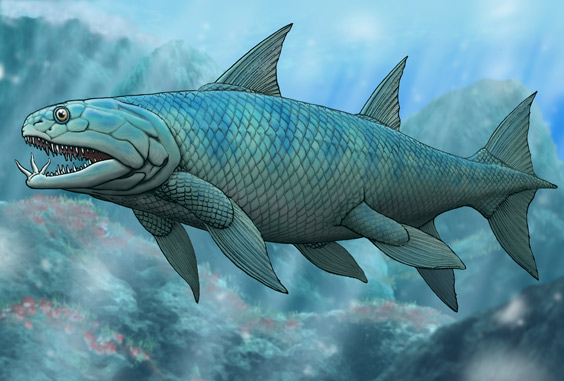Finding that fish fossil proved easy. By the turn of the 19th century
寻找那条鱼的化石好像并不难。到了19世纪末
all eyes were on a Devonian group called the lobe-finned.
所有目光都聚集在泥盆纪的一类鱼身上,它们叫做肉鳍鱼
Lobe-finned uniquely have a bone structure in their fins that seems to be a precursor to our legs and arms
肉鳍鱼的鳍内有独特的骨结构,看起来像是腿或胳膊的前身
and one particular lobe-finned, the long extinct eusthenopteron had all the leg bones except the feet and toes.
尤其是一类肉鳍鱼--早已灭绝的真掌鳍鱼,几乎拥有所有腿骨,只是少了足和趾
Here in these fossils the limb was just laid out simply beautifully
这些化石中伸展出来的肢非常完整,
and it was so easy to turn it in your mind into a tetrapod when these bones,
不难想象它将进化成四足动物,这些骨头,
the 1 and the 2 bones, they were, they were laid out and there were these
这一根和这两根骨头都已伸长
bits in the, the, the ankle and the, the wrist and so on.

Absolutely fantastic, beautiful material, clinched it really.
真是太神奇了,非常好的资料,把它都串起来了
What they thought they'd clinched was the fish from which we all came, the ancestor without legs,
他们所说的串起来的就是我们起源的那种鱼,一个没有腿的祖先
and early last century scholars developed a theory to explain why it might have evolved legs and started walking.
上世纪初,有学者提出了一种理论,用来解释它为何进化出腿并开始行走
That brutal Devonian sun must have been the cause of droughts.
泥盆纪毒辣的阳光一定是引起干旱的原因
Fish would have been trapped in drying pools and faced death.
鱼可能困在日渐干涸的水塘中,面临着死亡的威胁
To survive a few eusthenopterons must have dragged themselves on their fins,
为了活下去,一小部分真掌鳍鱼不得不用它们的鳍撑着身体
as mudskippers do today, out of the puddles in search of deeper water.


